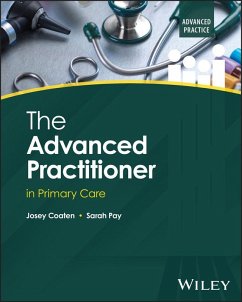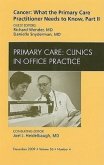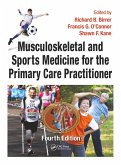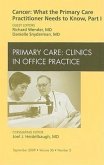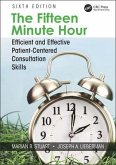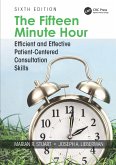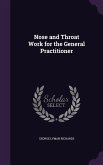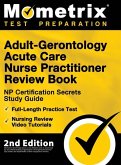- Broschiertes Buch
- Merkliste
- Auf die Merkliste
- Bewerten Bewerten
- Teilen
- Produkt teilen
- Produkterinnerung
- Produkterinnerung
Equipping Advanced Practitioners with the skills, insight, and confidence to lead in modern primary care The Advanced Practitioner in Primary Care is a timely resource that provides current and aspiring Advanced Practitioners (APs) with a practical roadmap for delivering high-quality, patient-centred care in complex and fast-paced primary care environments. Built on the four pillars of advanced practice-clinical practice, leadership, education, and research-this text supports practitioners in bridging the gap between academic theory and clinical application. Written by experienced clinicians…mehr
Andere Kunden interessierten sich auch für
![Cancer: What the Primary Care Practitioner Needs to Know, Part II, an Issue of Primary Care Clinics in Office Practice Cancer: What the Primary Care Practitioner Needs to Know, Part II, an Issue of Primary Care Clinics in Office Practice]() Richard WenderCancer: What the Primary Care Practitioner Needs to Know, Part II, an Issue of Primary Care Clinics in Office Practice56,99 €
Richard WenderCancer: What the Primary Care Practitioner Needs to Know, Part II, an Issue of Primary Care Clinics in Office Practice56,99 €![Musculoskeletal and Sports Medicine For The Primary Care Practitioner Musculoskeletal and Sports Medicine For The Primary Care Practitioner]() Musculoskeletal and Sports Medicine For The Primary Care Practitioner45,99 €
Musculoskeletal and Sports Medicine For The Primary Care Practitioner45,99 €![Cancer: What the Primary Care Practitioner Needs to Know, Part I, an Issue of Primary Care Clinics in Office Practice Cancer: What the Primary Care Practitioner Needs to Know, Part I, an Issue of Primary Care Clinics in Office Practice]() Richard WenderCancer: What the Primary Care Practitioner Needs to Know, Part I, an Issue of Primary Care Clinics in Office Practice56,99 €
Richard WenderCancer: What the Primary Care Practitioner Needs to Know, Part I, an Issue of Primary Care Clinics in Office Practice56,99 €![The Fifteen Minute Hour The Fifteen Minute Hour]() Marian StuartThe Fifteen Minute Hour28,99 €
Marian StuartThe Fifteen Minute Hour28,99 €![The Fifteen Minute Hour The Fifteen Minute Hour]() Marian StuartThe Fifteen Minute Hour203,99 €
Marian StuartThe Fifteen Minute Hour203,99 €![Nose and Throat Work for the General Practitioner Nose and Throat Work for the General Practitioner]() George Lyman RichardsNose and Throat Work for the General Practitioner32,99 €
George Lyman RichardsNose and Throat Work for the General Practitioner32,99 €![Adult-Gerontology Acute Care Nurse Practitioner Review Book - NP Certification Secrets Study Guide, Full-Length Practice Test, Nursing Review Video Tutorials Adult-Gerontology Acute Care Nurse Practitioner Review Book - NP Certification Secrets Study Guide, Full-Length Practice Test, Nursing Review Video Tutorials]() Adult-Gerontology Acute Care Nurse Practitioner Review Book - NP Certification Secrets Study Guide, Full-Length Practice Test, Nursing Review Video Tutorials62,99 €
Adult-Gerontology Acute Care Nurse Practitioner Review Book - NP Certification Secrets Study Guide, Full-Length Practice Test, Nursing Review Video Tutorials62,99 €-
-
-
Equipping Advanced Practitioners with the skills, insight, and confidence to lead in modern primary care The Advanced Practitioner in Primary Care is a timely resource that provides current and aspiring Advanced Practitioners (APs) with a practical roadmap for delivering high-quality, patient-centred care in complex and fast-paced primary care environments. Built on the four pillars of advanced practice-clinical practice, leadership, education, and research-this text supports practitioners in bridging the gap between academic theory and clinical application. Written by experienced clinicians and educators, this book is framed by national and international guidelines-applicable to adult, paediatric, and mental health contexts-and reinforced by real-world case studies that contextualise concepts and build confidence in managing diverse clinical scenarios. Providing the structured support and evidence-informed guidance necessary for confident, competent, and reflective practice, The Advanced Practitioner in Primary Care: * Covers complex consultation skills, clinical reasoning, systems-based clinical assessments, and decision-making with evidence-informed guidance * Addresses the management of uncertainty and diverse patient presentations, including frailty and paediatrics * Offers practical insights on getting the most from supervision and professional development pathways * Includes a dedicated chapter on prescribing and medication management tailored for APs * Discusses the evolving scope of the AP role in the context of local, national, and international policy The Advanced Practitioner in Primary Care is essential reading for trainee and established APs working in primary care, as well as for nurses, paramedics, pharmacists, physiotherapists, and other professionals transitioning into general practice. It is also ideal for postgraduate programmes in advanced clinical practice and a valuable resource for educators and primary care teams supporting AP development.
Produktdetails
- Produktdetails
- Verlag: John Wiley & Sons Inc
- Seitenzahl: 464
- Erscheinungstermin: 29. Januar 2026
- Englisch
- ISBN-13: 9781394253739
- ISBN-10: 1394253737
- Artikelnr.: 75285199
- Herstellerkennzeichnung
- Libri GmbH
- Europaallee 1
- 36244 Bad Hersfeld
- gpsr@libri.de
- Verlag: John Wiley & Sons Inc
- Seitenzahl: 464
- Erscheinungstermin: 29. Januar 2026
- Englisch
- ISBN-13: 9781394253739
- ISBN-10: 1394253737
- Artikelnr.: 75285199
- Herstellerkennzeichnung
- Libri GmbH
- Europaallee 1
- 36244 Bad Hersfeld
- gpsr@libri.de
Josey Coaten is a lecturer and Programme Director for the MSc Advanced Clinical Practice at the University of Hull. An experienced registered nurse and Advanced Clinical Practitioner, she is also a non-medical independent prescriber. Josey brings extensive experience from primary care, having held roles from practice nurse to Senior ACP. She holds a postgraduate certificate in academic practice and is a Fellow of AdvancedHE. Sarah Pay has experience as a lecturer in the MSc Advanced Clinical Practice programme at the University of Hull and currently works as an ACP and clinical educator at Haxby Group. With a background in adult nursing, she has worked extensively in primary care as both a practice nurse and a Senior ACP. She is a non-medical prescriber and holds a postgraduate certificate in academic practice, as well as being a Fellow of AdvancedHE.
Unit 1 - The ACP Role in Primary Care
Chapter 1 Scope of Practice and the ACP role in primary care
Josey Coaten
Aim
Learning outcomes
Introduction
Chapter 2 How to get the most from supervision in practice
Sarah Pay
Aim
Learning Outcomes
Introduction
What is supervision?
Competence and Capability
Frameworks and Standards
Tailored Supervision
Planning Supervision in Primary care
Overcoming barriers to supervision
Demonstrating capability
Self- Awareness
Reflective Points
References
Chapter 3 Patient Centred Care
Josey Coaten
Aim
Learning outcomes
Introduction
Chapter 4 Clinical Uncertainty
Sarah Pay
Aim
Learning Outcomes
Introduction
Types of Uncertainty
Managing uncertainty
Information gathering
The value of time as a tool
Safety Netting
Ethical Considerations and shared decision making
Back to Basics
Communicating uncertainty
Uncertainty and Burnout
Reflective point
References
Unit 2 - Leadership
Chapter 5 Leadership
Josey Coaten
Aims
Learning outcomes
Introduction
Chapter 6 Research Pillar in Primary Care
Sarah Pay
Aims
Learning Outcomes
Introduction
The importance of the research pillar for ACPs
Challenges of embedding research into primary care ACP roles
Evidence Based Practice
Research Opportunities and the National Institute for Health can Care
Research (NIHR)
Clinical Academic Roles
Quality Improvement
Audit
Reflective Points
References
Chapter 7 Education and Teaching
Josey Coaten
Aims
Learning Outcomes
Introduction
Unit 3 - Consultation skills
Chapter 8 Consultation Models
Sarah Pay
Aims
Learning Outcomes
Introduction
Consultation Models Introduction
Overview of Models
Using a model in practice
The short or 15 minute consultation and agenda setting
Remote Consultations
Conclusion
Reflective points
References
Chapter 9 Advanced Clinical Reasoning
Josey Coaten
Aims
Learning Outcomes
Introduction
Unit 4 - Clinical Examination and Assessment
Chapter 10 History Taking
Sarah Pay
Aims
Learning outcomes
Introduction
Applying Structure to history taking
Care study
Preparation (Housekeeping)
Introduction and Rapport Building
Presenting Complaint
Ideas, Concerns and expectations
History of Presenting complaint
Past Medical History
Vaccination History
Medication History
Allergies
Family History
Social History
Occupation
Travel
Sexual history
Systematic enquiry
Closing the encounter
Difficult Consultations
Collateral History Taking
Communication considerations in history taking
Managing time
Digital tools in history taking
Care study reflection
References
Chapter 11 Introduction to clinical examination in primary care
Sarah Pay
Aims
Learning Outcomes
Introduction
Equipment
Home Visits
The acutely unwell patient
Red Flags
Chaperone
Structured examination principles
Preparation/Housekeeping
Environment
End of bed/chair
Inspection
Hands
Face and Mouth
Palpation
Percussion
Auscultation
Lymph Node Assessment
History considerations
Inspection
Palpation
Red flag signs for lymphadenopathy
Typical features of lymph nodes and associated pathology
Decision making, referrals or admissions
Case Study - Lymphadenopathy
Closer Look- Lymphoma
References
Chapter 12 The Respiratory System
Sarah Pay
Aims
Learning Outcomes
Introduction
History taking for the respiratory presentation
Preparation
Initiating the consultation
Taking a respiratory history
Common Presenting Symptoms
Chest pain
Cough
Sputum
Breathlessness
Wheeze
Stridor
Haemoptysis
Fever/Night sweats and Rigors
Weight Changes
Sleepiness
Red Flags
Clinical Examination of the respiratory system
Environment
End of the bed assessment
Hands and arms
Face, eyes and mouth
Neck
Inspection
Palpation
Percussion
Auscultation
Posterior
Legs
Common Presenting complaints in primary care
Other investigations in primary care
Pulse Oximetry
Sputum Cultures
Spirometry
ECG
Peak Flow
Fractional exhaled nitric oxide
Chest X-ray
Blood tests
Rapid point of care testing for C-Reactive Protein
Pertussis testing
Risk tools
Case Study - Community Acquired Pneumonia
References
Chapter 13 The Cardiovascular System
Josey Coaten
Aims
Learning outcomes
Introduction
Chapter 14 Abdomen/Urology and Gynaecology
Josey Coaten
Aims
Learning outcomes
Introduction
Chapter 15 Neurological Assessment
Josey Coaten
Aims
Learning Outcomes
Introduction
Chapter 16 Musculoskeletal and Rheumatology
Sarah Pay
Aims
Learning Outcomes
Introduction
Chapter 17 Ear, Nose and Throat
Josey Coaten
Aims
Learning Outcomes
Introduction
Chapter 18 Dermatology
Sarah Pay
Aims
Learning Outcomes
Introduction
Taking a dermatological history
Common presenting symptoms
Itching
Rash
Lesions
Pain
Psychosocial factors
Examination of skin
Inspection
Description
Palpation
Systematic Review
Examination of moles
Dermoscopy and photography
Red flags
Case study
References
Chapter 19 Paediatrics in Primary care
Sarah Pay
Aims
Learning Outcomes
Introduction
Initiating the consultation with a child and history taking
First Impressions
Introductions and Rapport building
Golden minute and establishing ICE
Taking a history
Examination
Airway
Breathing
Compromised respiratory system
Respiratory distress
Respiratory Rate
Oxygen saturation
Chest Auscultation
Circulation
Colour
Heart Rate
Capillary Refill time
Blood Pressure
Disability
ENT Examination
Temperature
Tummy
Blood Glucose
Examination Tips
Identifying serious illness in children
Vital signs
Traffic light system/PEWS/Sepsis
The Febrile Child
Management and parental/carer advice
The unexplained fever
Growth and Feeding
Safety netting
Professional and Legal Issues in Paediatrics
Consent
Gillick Competence
Fraser Guidelines
Safeguarding
Prescribing for children
Closer look - Kawasaki Disease
Case Study - Bronchiolitis
Common differential in primary care - feverish illness
Useful resources
References
Chapter 20 Mental Health in Primary Care
Sarah Pay
Aims
Learning Outcomes
Introduction
History taking in Mental Health consultations
Mental Status Examination (MSE)
Determining risk
Ethnicity
Frailty
Maternal Mental Health
Learning Disability
Gender
History taking framework for mental health
Legislation and mental health
The Mental Health Act 1983
The Mental Capacity Act 2005
Management of common low risk presentations in primary care
Social Prescribing
Generalised anxiety disorders
Depression
Bi-Polar Disorder
Mental health of the practitioner
Useful information
Case study - depression
References
Chapter 21 Frailty
Josey Coaten
Aims
Learning outcomes
Introduction
Chapter 22 The advanced Practitioner as a Prescriber
Sarah Pay
Aims
Learning Outcomes
Introduction
NMP Professional Considerations
The NMP and Scope of practice in primary care
Continuing professional development as a prescriber
Remote Prescribing
Repeat Prescribing
Medication Reviews
Re-authorisation of repeat medications
Medication Review
Structured Medication Review (SMR)
Medicine Reconciliation
Polypharmacy
Medicines Optimisation
Medicined optimisation for older people
Antimicrobial stewardship
Delayed prescriptions
Communication regarding antibiotic prescribing
Supporting other NMP's
Reflection Activity
References
Chapter 23 Completing the consultation/developing as an ACP and beyond
Josey Coaten
Aims
Learning Outcomes
Introduction
Chapter 1 Scope of Practice and the ACP role in primary care
Josey Coaten
Aim
Learning outcomes
Introduction
Chapter 2 How to get the most from supervision in practice
Sarah Pay
Aim
Learning Outcomes
Introduction
What is supervision?
Competence and Capability
Frameworks and Standards
Tailored Supervision
Planning Supervision in Primary care
Overcoming barriers to supervision
Demonstrating capability
Self- Awareness
Reflective Points
References
Chapter 3 Patient Centred Care
Josey Coaten
Aim
Learning outcomes
Introduction
Chapter 4 Clinical Uncertainty
Sarah Pay
Aim
Learning Outcomes
Introduction
Types of Uncertainty
Managing uncertainty
Information gathering
The value of time as a tool
Safety Netting
Ethical Considerations and shared decision making
Back to Basics
Communicating uncertainty
Uncertainty and Burnout
Reflective point
References
Unit 2 - Leadership
Chapter 5 Leadership
Josey Coaten
Aims
Learning outcomes
Introduction
Chapter 6 Research Pillar in Primary Care
Sarah Pay
Aims
Learning Outcomes
Introduction
The importance of the research pillar for ACPs
Challenges of embedding research into primary care ACP roles
Evidence Based Practice
Research Opportunities and the National Institute for Health can Care
Research (NIHR)
Clinical Academic Roles
Quality Improvement
Audit
Reflective Points
References
Chapter 7 Education and Teaching
Josey Coaten
Aims
Learning Outcomes
Introduction
Unit 3 - Consultation skills
Chapter 8 Consultation Models
Sarah Pay
Aims
Learning Outcomes
Introduction
Consultation Models Introduction
Overview of Models
Using a model in practice
The short or 15 minute consultation and agenda setting
Remote Consultations
Conclusion
Reflective points
References
Chapter 9 Advanced Clinical Reasoning
Josey Coaten
Aims
Learning Outcomes
Introduction
Unit 4 - Clinical Examination and Assessment
Chapter 10 History Taking
Sarah Pay
Aims
Learning outcomes
Introduction
Applying Structure to history taking
Care study
Preparation (Housekeeping)
Introduction and Rapport Building
Presenting Complaint
Ideas, Concerns and expectations
History of Presenting complaint
Past Medical History
Vaccination History
Medication History
Allergies
Family History
Social History
Occupation
Travel
Sexual history
Systematic enquiry
Closing the encounter
Difficult Consultations
Collateral History Taking
Communication considerations in history taking
Managing time
Digital tools in history taking
Care study reflection
References
Chapter 11 Introduction to clinical examination in primary care
Sarah Pay
Aims
Learning Outcomes
Introduction
Equipment
Home Visits
The acutely unwell patient
Red Flags
Chaperone
Structured examination principles
Preparation/Housekeeping
Environment
End of bed/chair
Inspection
Hands
Face and Mouth
Palpation
Percussion
Auscultation
Lymph Node Assessment
History considerations
Inspection
Palpation
Red flag signs for lymphadenopathy
Typical features of lymph nodes and associated pathology
Decision making, referrals or admissions
Case Study - Lymphadenopathy
Closer Look- Lymphoma
References
Chapter 12 The Respiratory System
Sarah Pay
Aims
Learning Outcomes
Introduction
History taking for the respiratory presentation
Preparation
Initiating the consultation
Taking a respiratory history
Common Presenting Symptoms
Chest pain
Cough
Sputum
Breathlessness
Wheeze
Stridor
Haemoptysis
Fever/Night sweats and Rigors
Weight Changes
Sleepiness
Red Flags
Clinical Examination of the respiratory system
Environment
End of the bed assessment
Hands and arms
Face, eyes and mouth
Neck
Inspection
Palpation
Percussion
Auscultation
Posterior
Legs
Common Presenting complaints in primary care
Other investigations in primary care
Pulse Oximetry
Sputum Cultures
Spirometry
ECG
Peak Flow
Fractional exhaled nitric oxide
Chest X-ray
Blood tests
Rapid point of care testing for C-Reactive Protein
Pertussis testing
Risk tools
Case Study - Community Acquired Pneumonia
References
Chapter 13 The Cardiovascular System
Josey Coaten
Aims
Learning outcomes
Introduction
Chapter 14 Abdomen/Urology and Gynaecology
Josey Coaten
Aims
Learning outcomes
Introduction
Chapter 15 Neurological Assessment
Josey Coaten
Aims
Learning Outcomes
Introduction
Chapter 16 Musculoskeletal and Rheumatology
Sarah Pay
Aims
Learning Outcomes
Introduction
Chapter 17 Ear, Nose and Throat
Josey Coaten
Aims
Learning Outcomes
Introduction
Chapter 18 Dermatology
Sarah Pay
Aims
Learning Outcomes
Introduction
Taking a dermatological history
Common presenting symptoms
Itching
Rash
Lesions
Pain
Psychosocial factors
Examination of skin
Inspection
Description
Palpation
Systematic Review
Examination of moles
Dermoscopy and photography
Red flags
Case study
References
Chapter 19 Paediatrics in Primary care
Sarah Pay
Aims
Learning Outcomes
Introduction
Initiating the consultation with a child and history taking
First Impressions
Introductions and Rapport building
Golden minute and establishing ICE
Taking a history
Examination
Airway
Breathing
Compromised respiratory system
Respiratory distress
Respiratory Rate
Oxygen saturation
Chest Auscultation
Circulation
Colour
Heart Rate
Capillary Refill time
Blood Pressure
Disability
ENT Examination
Temperature
Tummy
Blood Glucose
Examination Tips
Identifying serious illness in children
Vital signs
Traffic light system/PEWS/Sepsis
The Febrile Child
Management and parental/carer advice
The unexplained fever
Growth and Feeding
Safety netting
Professional and Legal Issues in Paediatrics
Consent
Gillick Competence
Fraser Guidelines
Safeguarding
Prescribing for children
Closer look - Kawasaki Disease
Case Study - Bronchiolitis
Common differential in primary care - feverish illness
Useful resources
References
Chapter 20 Mental Health in Primary Care
Sarah Pay
Aims
Learning Outcomes
Introduction
History taking in Mental Health consultations
Mental Status Examination (MSE)
Determining risk
Ethnicity
Frailty
Maternal Mental Health
Learning Disability
Gender
History taking framework for mental health
Legislation and mental health
The Mental Health Act 1983
The Mental Capacity Act 2005
Management of common low risk presentations in primary care
Social Prescribing
Generalised anxiety disorders
Depression
Bi-Polar Disorder
Mental health of the practitioner
Useful information
Case study - depression
References
Chapter 21 Frailty
Josey Coaten
Aims
Learning outcomes
Introduction
Chapter 22 The advanced Practitioner as a Prescriber
Sarah Pay
Aims
Learning Outcomes
Introduction
NMP Professional Considerations
The NMP and Scope of practice in primary care
Continuing professional development as a prescriber
Remote Prescribing
Repeat Prescribing
Medication Reviews
Re-authorisation of repeat medications
Medication Review
Structured Medication Review (SMR)
Medicine Reconciliation
Polypharmacy
Medicines Optimisation
Medicined optimisation for older people
Antimicrobial stewardship
Delayed prescriptions
Communication regarding antibiotic prescribing
Supporting other NMP's
Reflection Activity
References
Chapter 23 Completing the consultation/developing as an ACP and beyond
Josey Coaten
Aims
Learning Outcomes
Introduction
Unit 1 - The ACP Role in Primary Care
Chapter 1 Scope of Practice and the ACP role in primary care
Josey Coaten
Aim
Learning outcomes
Introduction
Chapter 2 How to get the most from supervision in practice
Sarah Pay
Aim
Learning Outcomes
Introduction
What is supervision?
Competence and Capability
Frameworks and Standards
Tailored Supervision
Planning Supervision in Primary care
Overcoming barriers to supervision
Demonstrating capability
Self- Awareness
Reflective Points
References
Chapter 3 Patient Centred Care
Josey Coaten
Aim
Learning outcomes
Introduction
Chapter 4 Clinical Uncertainty
Sarah Pay
Aim
Learning Outcomes
Introduction
Types of Uncertainty
Managing uncertainty
Information gathering
The value of time as a tool
Safety Netting
Ethical Considerations and shared decision making
Back to Basics
Communicating uncertainty
Uncertainty and Burnout
Reflective point
References
Unit 2 - Leadership
Chapter 5 Leadership
Josey Coaten
Aims
Learning outcomes
Introduction
Chapter 6 Research Pillar in Primary Care
Sarah Pay
Aims
Learning Outcomes
Introduction
The importance of the research pillar for ACPs
Challenges of embedding research into primary care ACP roles
Evidence Based Practice
Research Opportunities and the National Institute for Health can Care
Research (NIHR)
Clinical Academic Roles
Quality Improvement
Audit
Reflective Points
References
Chapter 7 Education and Teaching
Josey Coaten
Aims
Learning Outcomes
Introduction
Unit 3 - Consultation skills
Chapter 8 Consultation Models
Sarah Pay
Aims
Learning Outcomes
Introduction
Consultation Models Introduction
Overview of Models
Using a model in practice
The short or 15 minute consultation and agenda setting
Remote Consultations
Conclusion
Reflective points
References
Chapter 9 Advanced Clinical Reasoning
Josey Coaten
Aims
Learning Outcomes
Introduction
Unit 4 - Clinical Examination and Assessment
Chapter 10 History Taking
Sarah Pay
Aims
Learning outcomes
Introduction
Applying Structure to history taking
Care study
Preparation (Housekeeping)
Introduction and Rapport Building
Presenting Complaint
Ideas, Concerns and expectations
History of Presenting complaint
Past Medical History
Vaccination History
Medication History
Allergies
Family History
Social History
Occupation
Travel
Sexual history
Systematic enquiry
Closing the encounter
Difficult Consultations
Collateral History Taking
Communication considerations in history taking
Managing time
Digital tools in history taking
Care study reflection
References
Chapter 11 Introduction to clinical examination in primary care
Sarah Pay
Aims
Learning Outcomes
Introduction
Equipment
Home Visits
The acutely unwell patient
Red Flags
Chaperone
Structured examination principles
Preparation/Housekeeping
Environment
End of bed/chair
Inspection
Hands
Face and Mouth
Palpation
Percussion
Auscultation
Lymph Node Assessment
History considerations
Inspection
Palpation
Red flag signs for lymphadenopathy
Typical features of lymph nodes and associated pathology
Decision making, referrals or admissions
Case Study - Lymphadenopathy
Closer Look- Lymphoma
References
Chapter 12 The Respiratory System
Sarah Pay
Aims
Learning Outcomes
Introduction
History taking for the respiratory presentation
Preparation
Initiating the consultation
Taking a respiratory history
Common Presenting Symptoms
Chest pain
Cough
Sputum
Breathlessness
Wheeze
Stridor
Haemoptysis
Fever/Night sweats and Rigors
Weight Changes
Sleepiness
Red Flags
Clinical Examination of the respiratory system
Environment
End of the bed assessment
Hands and arms
Face, eyes and mouth
Neck
Inspection
Palpation
Percussion
Auscultation
Posterior
Legs
Common Presenting complaints in primary care
Other investigations in primary care
Pulse Oximetry
Sputum Cultures
Spirometry
ECG
Peak Flow
Fractional exhaled nitric oxide
Chest X-ray
Blood tests
Rapid point of care testing for C-Reactive Protein
Pertussis testing
Risk tools
Case Study - Community Acquired Pneumonia
References
Chapter 13 The Cardiovascular System
Josey Coaten
Aims
Learning outcomes
Introduction
Chapter 14 Abdomen/Urology and Gynaecology
Josey Coaten
Aims
Learning outcomes
Introduction
Chapter 15 Neurological Assessment
Josey Coaten
Aims
Learning Outcomes
Introduction
Chapter 16 Musculoskeletal and Rheumatology
Sarah Pay
Aims
Learning Outcomes
Introduction
Chapter 17 Ear, Nose and Throat
Josey Coaten
Aims
Learning Outcomes
Introduction
Chapter 18 Dermatology
Sarah Pay
Aims
Learning Outcomes
Introduction
Taking a dermatological history
Common presenting symptoms
Itching
Rash
Lesions
Pain
Psychosocial factors
Examination of skin
Inspection
Description
Palpation
Systematic Review
Examination of moles
Dermoscopy and photography
Red flags
Case study
References
Chapter 19 Paediatrics in Primary care
Sarah Pay
Aims
Learning Outcomes
Introduction
Initiating the consultation with a child and history taking
First Impressions
Introductions and Rapport building
Golden minute and establishing ICE
Taking a history
Examination
Airway
Breathing
Compromised respiratory system
Respiratory distress
Respiratory Rate
Oxygen saturation
Chest Auscultation
Circulation
Colour
Heart Rate
Capillary Refill time
Blood Pressure
Disability
ENT Examination
Temperature
Tummy
Blood Glucose
Examination Tips
Identifying serious illness in children
Vital signs
Traffic light system/PEWS/Sepsis
The Febrile Child
Management and parental/carer advice
The unexplained fever
Growth and Feeding
Safety netting
Professional and Legal Issues in Paediatrics
Consent
Gillick Competence
Fraser Guidelines
Safeguarding
Prescribing for children
Closer look - Kawasaki Disease
Case Study - Bronchiolitis
Common differential in primary care - feverish illness
Useful resources
References
Chapter 20 Mental Health in Primary Care
Sarah Pay
Aims
Learning Outcomes
Introduction
History taking in Mental Health consultations
Mental Status Examination (MSE)
Determining risk
Ethnicity
Frailty
Maternal Mental Health
Learning Disability
Gender
History taking framework for mental health
Legislation and mental health
The Mental Health Act 1983
The Mental Capacity Act 2005
Management of common low risk presentations in primary care
Social Prescribing
Generalised anxiety disorders
Depression
Bi-Polar Disorder
Mental health of the practitioner
Useful information
Case study - depression
References
Chapter 21 Frailty
Josey Coaten
Aims
Learning outcomes
Introduction
Chapter 22 The advanced Practitioner as a Prescriber
Sarah Pay
Aims
Learning Outcomes
Introduction
NMP Professional Considerations
The NMP and Scope of practice in primary care
Continuing professional development as a prescriber
Remote Prescribing
Repeat Prescribing
Medication Reviews
Re-authorisation of repeat medications
Medication Review
Structured Medication Review (SMR)
Medicine Reconciliation
Polypharmacy
Medicines Optimisation
Medicined optimisation for older people
Antimicrobial stewardship
Delayed prescriptions
Communication regarding antibiotic prescribing
Supporting other NMP's
Reflection Activity
References
Chapter 23 Completing the consultation/developing as an ACP and beyond
Josey Coaten
Aims
Learning Outcomes
Introduction
Chapter 1 Scope of Practice and the ACP role in primary care
Josey Coaten
Aim
Learning outcomes
Introduction
Chapter 2 How to get the most from supervision in practice
Sarah Pay
Aim
Learning Outcomes
Introduction
What is supervision?
Competence and Capability
Frameworks and Standards
Tailored Supervision
Planning Supervision in Primary care
Overcoming barriers to supervision
Demonstrating capability
Self- Awareness
Reflective Points
References
Chapter 3 Patient Centred Care
Josey Coaten
Aim
Learning outcomes
Introduction
Chapter 4 Clinical Uncertainty
Sarah Pay
Aim
Learning Outcomes
Introduction
Types of Uncertainty
Managing uncertainty
Information gathering
The value of time as a tool
Safety Netting
Ethical Considerations and shared decision making
Back to Basics
Communicating uncertainty
Uncertainty and Burnout
Reflective point
References
Unit 2 - Leadership
Chapter 5 Leadership
Josey Coaten
Aims
Learning outcomes
Introduction
Chapter 6 Research Pillar in Primary Care
Sarah Pay
Aims
Learning Outcomes
Introduction
The importance of the research pillar for ACPs
Challenges of embedding research into primary care ACP roles
Evidence Based Practice
Research Opportunities and the National Institute for Health can Care
Research (NIHR)
Clinical Academic Roles
Quality Improvement
Audit
Reflective Points
References
Chapter 7 Education and Teaching
Josey Coaten
Aims
Learning Outcomes
Introduction
Unit 3 - Consultation skills
Chapter 8 Consultation Models
Sarah Pay
Aims
Learning Outcomes
Introduction
Consultation Models Introduction
Overview of Models
Using a model in practice
The short or 15 minute consultation and agenda setting
Remote Consultations
Conclusion
Reflective points
References
Chapter 9 Advanced Clinical Reasoning
Josey Coaten
Aims
Learning Outcomes
Introduction
Unit 4 - Clinical Examination and Assessment
Chapter 10 History Taking
Sarah Pay
Aims
Learning outcomes
Introduction
Applying Structure to history taking
Care study
Preparation (Housekeeping)
Introduction and Rapport Building
Presenting Complaint
Ideas, Concerns and expectations
History of Presenting complaint
Past Medical History
Vaccination History
Medication History
Allergies
Family History
Social History
Occupation
Travel
Sexual history
Systematic enquiry
Closing the encounter
Difficult Consultations
Collateral History Taking
Communication considerations in history taking
Managing time
Digital tools in history taking
Care study reflection
References
Chapter 11 Introduction to clinical examination in primary care
Sarah Pay
Aims
Learning Outcomes
Introduction
Equipment
Home Visits
The acutely unwell patient
Red Flags
Chaperone
Structured examination principles
Preparation/Housekeeping
Environment
End of bed/chair
Inspection
Hands
Face and Mouth
Palpation
Percussion
Auscultation
Lymph Node Assessment
History considerations
Inspection
Palpation
Red flag signs for lymphadenopathy
Typical features of lymph nodes and associated pathology
Decision making, referrals or admissions
Case Study - Lymphadenopathy
Closer Look- Lymphoma
References
Chapter 12 The Respiratory System
Sarah Pay
Aims
Learning Outcomes
Introduction
History taking for the respiratory presentation
Preparation
Initiating the consultation
Taking a respiratory history
Common Presenting Symptoms
Chest pain
Cough
Sputum
Breathlessness
Wheeze
Stridor
Haemoptysis
Fever/Night sweats and Rigors
Weight Changes
Sleepiness
Red Flags
Clinical Examination of the respiratory system
Environment
End of the bed assessment
Hands and arms
Face, eyes and mouth
Neck
Inspection
Palpation
Percussion
Auscultation
Posterior
Legs
Common Presenting complaints in primary care
Other investigations in primary care
Pulse Oximetry
Sputum Cultures
Spirometry
ECG
Peak Flow
Fractional exhaled nitric oxide
Chest X-ray
Blood tests
Rapid point of care testing for C-Reactive Protein
Pertussis testing
Risk tools
Case Study - Community Acquired Pneumonia
References
Chapter 13 The Cardiovascular System
Josey Coaten
Aims
Learning outcomes
Introduction
Chapter 14 Abdomen/Urology and Gynaecology
Josey Coaten
Aims
Learning outcomes
Introduction
Chapter 15 Neurological Assessment
Josey Coaten
Aims
Learning Outcomes
Introduction
Chapter 16 Musculoskeletal and Rheumatology
Sarah Pay
Aims
Learning Outcomes
Introduction
Chapter 17 Ear, Nose and Throat
Josey Coaten
Aims
Learning Outcomes
Introduction
Chapter 18 Dermatology
Sarah Pay
Aims
Learning Outcomes
Introduction
Taking a dermatological history
Common presenting symptoms
Itching
Rash
Lesions
Pain
Psychosocial factors
Examination of skin
Inspection
Description
Palpation
Systematic Review
Examination of moles
Dermoscopy and photography
Red flags
Case study
References
Chapter 19 Paediatrics in Primary care
Sarah Pay
Aims
Learning Outcomes
Introduction
Initiating the consultation with a child and history taking
First Impressions
Introductions and Rapport building
Golden minute and establishing ICE
Taking a history
Examination
Airway
Breathing
Compromised respiratory system
Respiratory distress
Respiratory Rate
Oxygen saturation
Chest Auscultation
Circulation
Colour
Heart Rate
Capillary Refill time
Blood Pressure
Disability
ENT Examination
Temperature
Tummy
Blood Glucose
Examination Tips
Identifying serious illness in children
Vital signs
Traffic light system/PEWS/Sepsis
The Febrile Child
Management and parental/carer advice
The unexplained fever
Growth and Feeding
Safety netting
Professional and Legal Issues in Paediatrics
Consent
Gillick Competence
Fraser Guidelines
Safeguarding
Prescribing for children
Closer look - Kawasaki Disease
Case Study - Bronchiolitis
Common differential in primary care - feverish illness
Useful resources
References
Chapter 20 Mental Health in Primary Care
Sarah Pay
Aims
Learning Outcomes
Introduction
History taking in Mental Health consultations
Mental Status Examination (MSE)
Determining risk
Ethnicity
Frailty
Maternal Mental Health
Learning Disability
Gender
History taking framework for mental health
Legislation and mental health
The Mental Health Act 1983
The Mental Capacity Act 2005
Management of common low risk presentations in primary care
Social Prescribing
Generalised anxiety disorders
Depression
Bi-Polar Disorder
Mental health of the practitioner
Useful information
Case study - depression
References
Chapter 21 Frailty
Josey Coaten
Aims
Learning outcomes
Introduction
Chapter 22 The advanced Practitioner as a Prescriber
Sarah Pay
Aims
Learning Outcomes
Introduction
NMP Professional Considerations
The NMP and Scope of practice in primary care
Continuing professional development as a prescriber
Remote Prescribing
Repeat Prescribing
Medication Reviews
Re-authorisation of repeat medications
Medication Review
Structured Medication Review (SMR)
Medicine Reconciliation
Polypharmacy
Medicines Optimisation
Medicined optimisation for older people
Antimicrobial stewardship
Delayed prescriptions
Communication regarding antibiotic prescribing
Supporting other NMP's
Reflection Activity
References
Chapter 23 Completing the consultation/developing as an ACP and beyond
Josey Coaten
Aims
Learning Outcomes
Introduction

